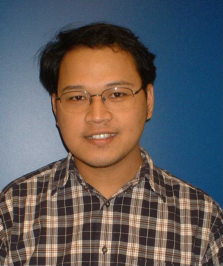Characterization and simulation of localized states in optical structures
Promotion Date: 14 December 2006
| My thesis is about mathematical modelling of resonant optical structures. Optical resonators are structures that usually consist of two building blocks: an optical cavity and an assisting structure that functions as a mirror. The cavity stores the light while the mirror prevents it from leaking out from the structure. In this type of structure, light can be localized for certain frequencies. The localization is due to the so called resonance phenomena, strongly enhancing the light will in the neighbourhood of the cavity. I have done modelling on this kind of structure. |
What was your thesis about?
My thesis is about mathematical modelling of resonant optical structures. Optical resonators are structures that usually consist of two building blocks: an optical cavity and an assisting structure that functions as a mirror. The cavity stores the light while the mirror prevents it from leaking out from the structure. In this type of structure, light can be localized for certain frequencies. The localization is due to the so called resonance phenomena, strongly enhancing the light will in the neighbourhood of the cavity. I have done modelling on this kind of structure.
Why would you want to trap or enhance the light in a structure like this?
Because of the enhancement of the light intensity around the cavity, it can be exploited to make devices such as filters or cavity lasers. Filters, because these resonances happen only for a few special frequencies, and lasers, because of the high intensity near the cavity due to the light enhancement.
Others have been working on these type of structures; what was your contribution to this research?
From a mathematical point of view we developed a method to identify the resonance of the localized state without having to perform the standard procedure used up till now, which is scanning through a transmission frequency and detecting the peaks.What we have done is developing a method with which to identify the resonant state directly.This is much more efficient: we do not have to search the resonances in the whole frequency range. I can also add that my method gives directly the “quality factor” of the resonance of the device. The quality factor is a measure that describes how this structure can retain the light. The higher the quality factor, the better results you will get for the applications. So there are actually two fundamental results.
How far are optical resonators off from actual applications would you say?
There are already a lot of experiments in other groups implementing this principle in devices, such as lasers. It is not far from applications at all.
What is your background, are you a mathematician?
Yes, I did my bachelor, master and PhD in the mathematics department.
Whereabouts?
I did my bachelor in Indonesia, where I am from, and I did my master’s and PhD here in Twente, in the group Applied Analysis and Mathematical Physics.
How did that happen?
About 5 years ago there were some workshops co-organized by University of Twente in the Bandung Institute of Technology, and the best among them were invited to do a Master’s in Twente and the possibility to continue to a PhD.
And what do you think of your stay?
For sure I learned a lot here in Twente and I also like the working environment. In free time I do a lot of cycling. In Indonesia it is not easy to cycle because of the hills.
What are your plans for the future?
I am certainly going back to Indonesia but I would like to work in science. There is a new research centre, called Labmath-Indonesia and most probably I will join there.
What kind of research do they do?
As far as a know subjects related to geo-mathematics and operations research.
But I would like to stay to work in optics for a few more years and hopefully I can contribute in this way to the science in the Institute.

